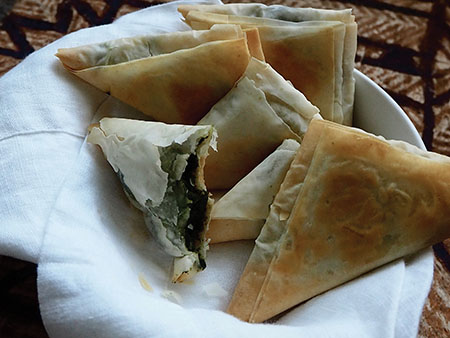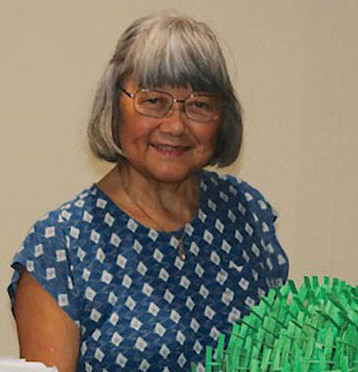
Charlene Asato is All About Paper
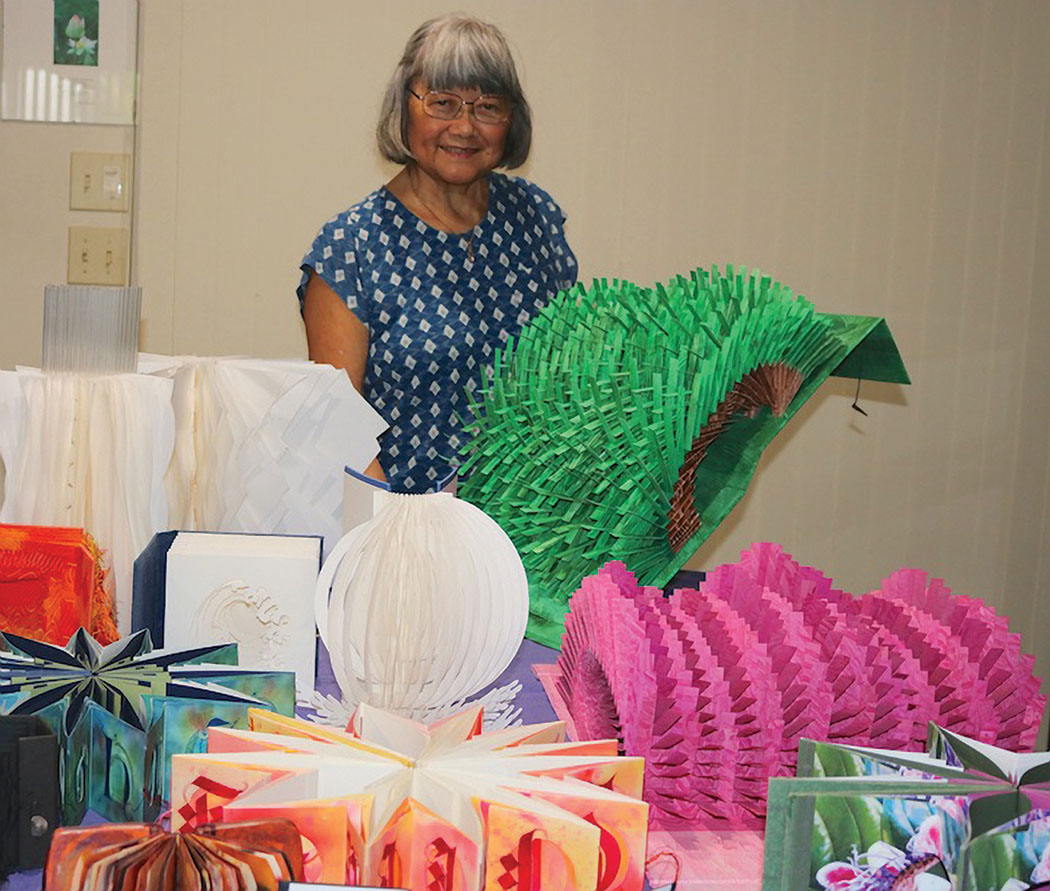
By Lynne Farr
Paper is only paper until it’s in the hands of Charlene Asato—then it’s art—or it will be. Charlene is going to cut, fold, emboss, dye, draw, twist, collage, letter, shred, sew, paint, pierce, pleat, print, paste, and make a book out of it…a very special book, one-of-a-kind. It’s called an artist’s book.
There are many types of artists’ books. Tyger, for example, is a “tunnel” book that illustrates William Blake’s poem, “Tyger! Tyger! burning bright, in the forests of the night…” Interestingly, William Blake is known as the father of artists’ books since he was the first to hand paint the covers of his written work, hand-bind, and self-distribute his unique editions in the early 1800s. However, that is not why Charlene Asato created Tyger. As she searched to find a good subject for calligraphy and watercolor painting, Tyger emerged. It’s a good bet that William Blake, if he could see Tyger, would wish he’d been the one to make it.
It wasn’t until the 1950s and 60s that anyone created a tunnel book, which is a unique meshing of storytelling with three-dimensional art. Artist Dieter Roth is credited as the first to make holes in the pages so you can see directly into the book. Charlene’s Lava Tube is a fitting example of the form.

While Tyger has six pages, Lava Tube has 25 pages that telescope out like bellows. The book illustrates the conduit formed by burning lava underneath the hardened surface of a lava flow. When the eruption slows, the rock cools and leaves a long tunnel. This tunnel book is made from two kinds of paper, paint, metallic beeswax paste, waxed linen thread, and binder board, and is an ideal way to portray the awesome volcanic action on Hawai‘i Island.
Charlene Asato grew up in Mountain View in East Hawai‘i. She earned her bachelor’s degree in art from the University of Hawai‘i at Hilo, then moved to California in 1967 where she and her husband raised a family.
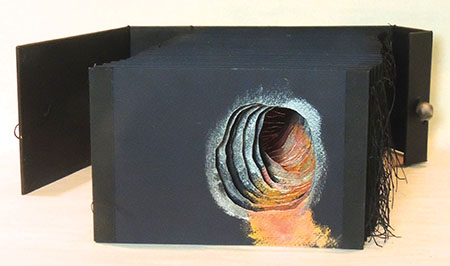
In 2003, they moved back to Mountain View, where Charlene built her studio as an extension of their home. In her light-filled space with its drawers and shelves of materials and equipment, inspiring books, examples of her earlier work, experiments with new ideas, and a huge table to work on, she is in her comfort zone, the right place to take chances, be surprised and expand her art.
In the 1980s, Charlene had taken calligraphy classes during which her teacher showed her a Japanese bound book, which featured an ancient method of hand binding. Her artist’s book Wrapping Summer Squash is a modified example of this system in which pages are sewn together using something like a blanket stitch.
A book called How to Wrap Five Eggs by Hideyuki Oka, illustrating Japanese folk-methods of packaging food, inspired Wrapping Summer Squash. Charlene took the concept to the limit and chose summer squash as her topic “because I wanted to do collage work with watercolors and papers I’d decorated. My subject had to be a fruit or vegetable with a variety of types, shapes, and colors. I finally chose summer squash and proceeded to show how to wrap them,” explains Charlene.
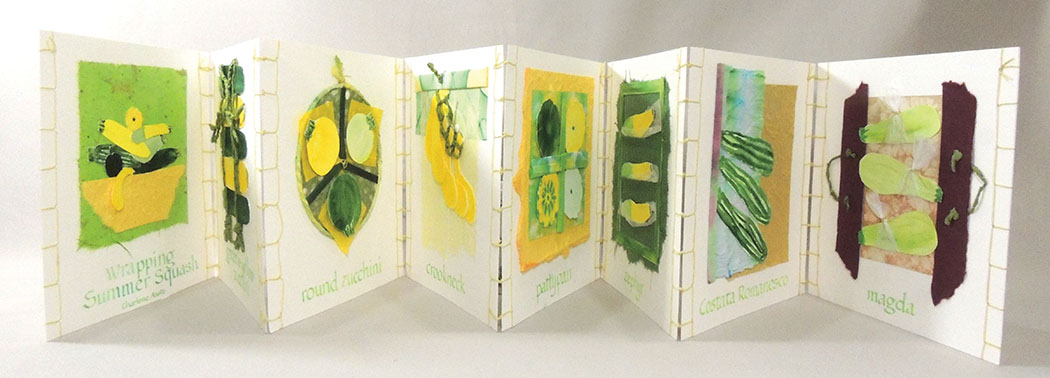
The squash-themed book includes a paper basket to fill with paper squash, paper string as a way to tie up the paper vegetables, paper pockets in which to tuck them, a painted leaf as a carrier, and a translucent wrap made of see-through paper. Each page is sewn to the next using the Japanese binding method. Charlene calls this a modified Japanese binding because she has bound each page to another instead of binding them all together as a more traditional book.
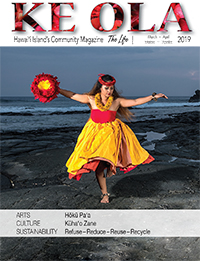
In the 1980s, the art of the book was blossoming worldwide. A calligraphy conference Charlene attended in California introduced new forms of artists’ books, leading her to increase her intimacy with paper. Though she had always enjoyed working with the vast array of papers available internationally, to create in three dimensions provided a new excitement.
Her “piano hinge” book entitled Jagged Edge takes her into the realm of sculpture. Created of paper and bamboo skewers, it is a beautiful flight of fancy, an imaginative departure from what we think of as a traditional book.
Charlene describes her experience in making Tea Path, “A piano hinge book can go on and on, creating straight paths, curved paths, or twisted paths. Bound with toothpicks, the Japanese paper, dyed with black tea, gives this book an earthy tone. It starts as a coil of paper and changes its shape as it unravels into whatever direction the viewer dictates.”
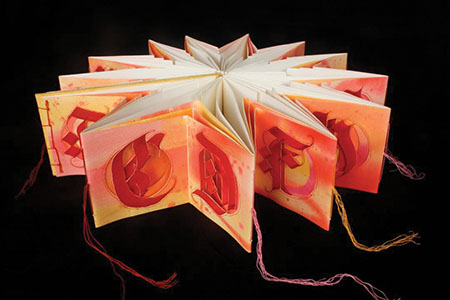
Her “star” book Abecedarian Gothic gave Charlene the opportunity to feature calligraphy on a three-dimensional canvas. According to various dictionaries, the word ‘abecedarian’ originated in the Middle Ages and means “a person teaching the alphabet,” “a person learning the alphabet,” or, as an adjective, “of the alphabet.”
Charlene’s book offers all three meanings: she teaches as we learn our ABCs in a brand new way, via Gothic lettering which appeared in the Middle Ages in illuminated manuscripts.
“With the 26 letters of the English language to write,” says Charlene, “I chose the star book structure with a tunnel book effect. The outer layer would have the majuscule [upper case] letters and the second layer, the miniscule [lower case]. The closed book looks like a typical codex bound book but it opens up to a 13-point starburst.”
Charlene gives credit as an innovative influence to Hedi Kyle, a mainstay in the book arts community. In 1979, Kyle pioneered the “flag” book, which Charlene takes to new heights. One example is her black and white Serendipitous Journey.
In Serendipitous Journey, a single drawing was cut and the pieces positioned on an accordion fold base so that the whole image is revealed when the covers are extended to the fullest, pulled almost flat. As the covers are moved back and forth, and the flags change position, more patterns are revealed.
Serendipitous Journey is a small book. When closed you can hold the book in the palm of your hand. Such a book can be made in a day.
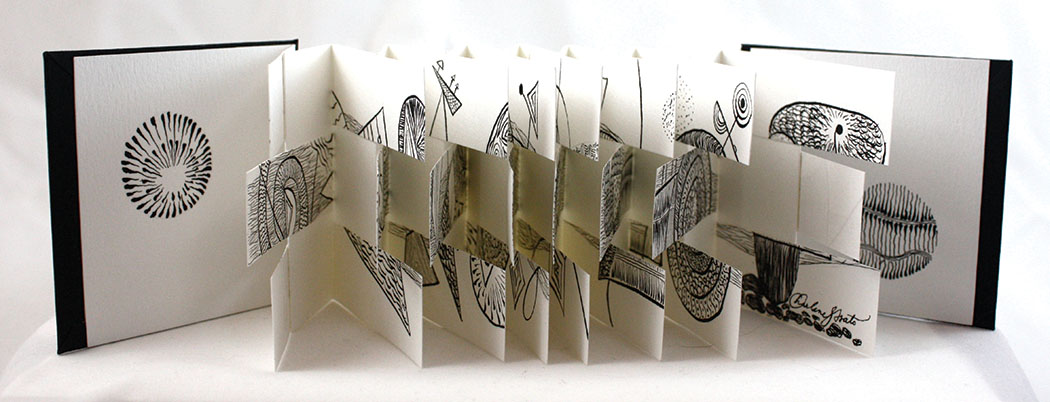
Her major flag book fantasies, however, are feats of engineering requiring the planning of a general, mathematical genius, eagle-eyed accuracy, and a skill earned from plenty of practice. Each book takes at least three weeks to make. For these books, Charlene needs to plan how much paper she will need in advance, because all the paper involved, not just for the cover art, but for the flags themselves, are hand painted by Charlene, using a technique called “paste paper,” similar to finger painting.
These are books like Verdant Knoll and Tickled Pink as shown by Charlene at the beginning of this story. They are books that need two hands to pick up and a stretch to open, all while marveling wide-eyed at the results. Her “double flag” book Cadence is also in this category.
In Cadence, the flags are going in both directions. They must rise and make their intricate patterns without bumping into each other and they all must flatten accurately when the book is closed.

When asked what is the hardest, maybe scariest, part of making these books one would think Charlene would discuss the measuring or the precision cutting and folding required; however, she says, “This is going to sound kind of crazy, but it’s the gluing. The covers have to be glued perfectly smoothly so there are no bubbles. Anytime I’m using glue it’s stressful. If you do it wrong, well…”
Charlene’s award-winning artist’s books have been exhibited in East Hawai‘i at Volcano Art Center, Wailoa Art Center, and East Hawai‘i Cultural Center where she had a solo exhibition in 2012, as well as in Missouri, Texas, Oregon, Georgia, Colorado, New York, and Sheffield, England. Her books have been collected by the Baylor University Library Collection in Texas; Denver, Colorado’s Public Library Douglas Fine Print Collection; the University of Alberta Library Collection in Canada; and by many private collectors.
Charlene has also taught bookbinding and paper arts at Volcano Art Center’s Niulani Campus, at East Hawai‘i Cultural Center, at her own studio, and she will teach it again. Meanwhile, she’ll be finding new ways to dazzle us with outrageous “how on earth did she do that?” beauty made with paper. ❖
For more information: chaleidesigns.com
Photos courtesy of Charlene Asato
